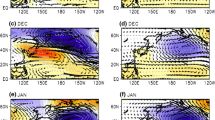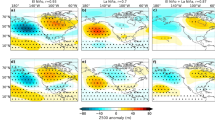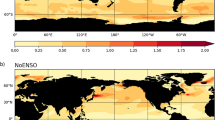Abstract
Previous studies with single models have suggested that El Niño teleconnections over North America could be different in a future warmer climate due to factors involving changes of El Niño event amplitude and/or changes in the midlatitude base state circulation. Here we analyze a six-member multi-model ensemble, three models with increasing future El Niño amplitude, and three models with decreasing future El Niño amplitude, to determine characteristics and possible changes to El Niño teleconnections during northern winter over the North Pacific and North America in a future warmer climate. Compared to observed El Niño events, all the models qualitatively produce general features of the observed teleconnection pattern over the North Pacific and North America, with an anomalously deepened Aleutian Low, a ridge over western North America, and anomalous low pressure over the southeastern United States. However, associated with systematic errors in the location of sea surface temperature and convective heating anomalies in the central and western equatorial Pacific (the models’ anomaly patterns are shifted to the west), the anomalous low pressure center in the North Pacific is weaker and shifted somewhat south compared to the observations. For future El Niño events, two different stabilization experiments are analyzed, one with CO2 held constant at year 2100 concentrations in the SRES A1B scenario (roughly doubled present-day CO2), and another with CO2 concentrations held constant at 4XCO2. Consistent with the earlier single model results, the future El Niño teleconnections are changed in the models, with a weakened as well as an eastward- and northward-shifted anomalous low in the North Pacific. This is associated with weakened anomalous warming over northern North America, strengthened cooling over southern North America, and precipitation increases in the Pacific Northwest in future events compared to present-day El Niño event teleconnections. These changes are consistent with the altered base state upper tropospheric circulation with a wave-5 pattern noted in previous studies that is shown here to be consistent across all the models whether there are projected future increases or decreases in El Niño amplitude. The future teleconnection changes are most consistent with this anomalous wave-5 pattern in the models with future increases of El Niño amplitude, but less so for the models with future decreases of El Niño amplitude.








Similar content being viewed by others
References
Achutarao K, Sperber K (2006) ENSO simulation in coupled ocean-atmosphere models: are the current models better? Clim Dyn 27. doi:10.1007/s00382-006-0119-7
Arblaster JM, Meehl GA, Moore A (2002) Interdecadal modulation of Australian rainfall. Clim Dyn 18:519–531
Branstator G, Haupt S (1998) An empirical model of barotropic atmospheric dynamics and its response to tropical forcing. J Clim 11:2645–2667
Capotondi A, et al (2006) Spatial and temporal structure of ENSO in 20th century coupled simulations. Ocean Model 15(3–4):274–298
Collins M (2000) The El Niño Southern oscillation in the second Hadley Centre coupled model and its response to greenhouse warming. J Clim 13:1299–1312
Guilyardi E (2005) El Niño-mean state-seasonal cycle interactions in a multi-model ensemble. Clim Dyn. doi:10.1007/s00382-005-0084-6
Guilyardi E, et al (2004) Representing El Niño in coupled ocean-atmosphere GCMs: the dominant role of the atmospheric component. J Clim 17:4623–4629
Joseph R, Nigam S (2006) ENSO evolution and teleconnections in IPCC 20th century climate simulations: realistic representation? J Clim 19:4360–4377
Knutson TR, Manabe S (1998) Model assessment of decadal variability and trends in the tropical Pacific Ocean. J Clim 11:2273–2296
Meehl GA (1987) The annual cycle and interannual variability in the tropical Pacific and Indian Ocean regions. Mon Weather Rev 115:27–50
Meehl GA, Branstator GW, Washington WM (1993) Tropical Pacific interannual variability and CO2 climate change. J Clim 6:42–63
Meehl GA, Washington WM, Collins WD, Arblaster JM, Hu A, Buja LE, Strand WG, Teng H (2005) How much more global warming and sea level rise? Science 307:1769–1772
Meehl GA, Teng H, Branstator GW (2006) Future changes of El Niño in two global coupled climate models. Clim Dyn. doi:10.1007/s00382-005-0098-0
Meehl GA, et al (2007a) Global climate projections. In: Climate Change 2007: The Physical Science Basis. Contribution of Working Group I to the Fourth Assessment Report of the Intergovernmental Panel on Climate Change, Cambridge University Press, Cambridge (in press)
Meehl GA, Covey C, Delworth T, Latif M, McAvaney B, Mitchell JFB, Stouffer RJ, Taylor KE (2007b) The WCRP CMIP3 multi-model dataset: a new era in climate change research. Bull Am Meteorol Soc (in press)
Merryfield W (2006) Changes to ENSO under CO2 doubling in a multi-model ensemble. J Clim 19:4009–4027
Rayner NA, Parker DE, Horton EB, Folland CK, Alexander LV, Rowell DP, Kent EC, Kaplan A (2003) Global analyses of sea surface temperature, sea ice, and night marine air temperature since the late nineteenth century. J Geophys Res 108(D14):4407. doi:10.1029/2002JD002670
Selten FM, Branstator GW, Dijkstra HA, Kliphuis M (2004) Tropical origins for recent and future Northern Hemisphere climate change. Geophys Res Lett 31:L21205. doi:10.1029/2004GL020739
Timmermann A (1999) Detecting the nonstationary response of ENSO to greenhouse warming. J Atmos Sci 56:2313–2325
van Loon H, Meehl GA, Milliff R (2003) The Southern oscillation in the early 1990s. Geophys Res Lett 30. doi:10.1029/2002GL016307
van Oldenborgh G, Philip S, Collins M (2005) El Niño in a changing climate: a multi-model study. Ocean Sci Discuss 2:267–298
Yasunari T (1991) “The monsoon year”–a new concept of the climatic year in the tropics. Bull Am Meteorol Soc 72:1331–1338
Acknowledgments
We acknowledge the modeling groups for making their simulations available for analysis, the Program for Climate Model Diagnosis and Intercomparison (PCMDI) for collecting and archiving the CMIP3 model output, and the WCRP’s Working Group on Coupled Models (WGCM) for organizing the model data analysis activity. The WCRP CMIP3 multi-model dataset is supported by the Office of Science, U.S. Department of Energy. This work was supported in part by the Office of Science, U.S. Department of Energy, Cooperative Agreement No. DE-FC02-97ER62402, and by the Weather and Climate Impact Assessment Initiative at the National Center for Atmospheric Research. The National Center for Atmospheric Research is sponsored by the National Science Foundation.
Author information
Authors and Affiliations
Corresponding author
Additional information
The National Center for Atmospheric Research is sponsored by the National Science Foundation.
Rights and permissions
About this article
Cite this article
Meehl, G.A., Teng, H. Multi-model changes in El Niño teleconnections over North America in a future warmer climate. Clim Dyn 29, 779–790 (2007). https://doi.org/10.1007/s00382-007-0268-3
Received:
Accepted:
Published:
Issue Date:
DOI: https://doi.org/10.1007/s00382-007-0268-3




